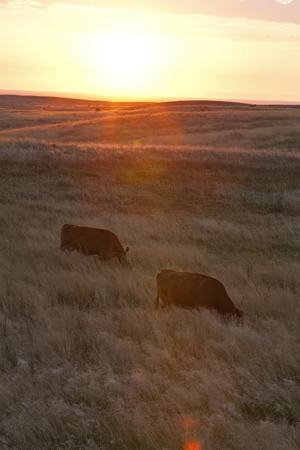The heat is on

With many parts of the country experiencing extreme heat, it is important to remember that cattle aren’t able to dissipate heat well and are more susceptible to heat stress. Cattle can experience heat stress at temperatures around 26oC, depending on the relative humidity. They don’t sweat as efficiently as other mammals, and the rumen produces a lot of heat through the process of fermentation; their temperature spikes four to six hours after feeding.
Heat stress can result in reduced feed intake, reduced daily gain, and death in extreme situations. Secondary effects such as acidosis or sickness from going off feed may also be an issue. Heat can reduce bull activity and change the way a cow shows signs of estrous which can result in a prolonged calving season. These various effects can add up to big dollars lost from a producer’s pocketbook if the risk or effects of heat stress aren’t reduced.
The risk or effects of heat stress can be reduced by:
- Ensuring access to clean water. Animals’ water requirements increase as the weather gets warmer. For example, yearlings will increase water consumption from 55 to 78 litres when temperatures rise from 26oC to 32oC. Clean waterers encourage cattle to continue to drink.
- Allowing access to shade
- Avoid working cattle, especially during the day
- Adjust feeding times/amounts. It is recommended that in hot temperatures animals are fed 70% of their feed 2-4 hours after the peak ambient temperature and that the dietary energy content is reduced by 5-7%
- Move cattle to new pastures in the evening
- Consider rotating through grazing pastures more frequently. Tall grass tends to be cooler and provides cattle with access to more highly fermentable forages which reduce the heat of fermentation in the rumen
- Ensure access to salt and mineral
- Avoid transporting cattle; if you must, reduce loading density, load later in the day, and do not leave cattle loaded in a stationary trailer any longer than necessary
- Provide proper fly control
- Keep a closer eye on the sick pen; like all forms of stress, animals that are sick, weak, or otherwise compromised are less likely to cope with heat stress
Implementing these tips is a good first step to mitigating the costly effects of hot temperatures.
The following resources can help you build your understanding of the effects of heat on cattle and develop short or longer-term solutions to help your cattle perform better in the summer heat.
Understanding heat stress
- Minimizing heat stress in beef cattle (Alberta Agriculture and Forestry)
- Tips to help cattle cope with the summertime heat stress (Canadian Cattlemen the Beef Magazine)
- Heat stress in beef cattle (Iowa State University)
- Understanding heat stress in cattle and the “thermal neutral zone” (Canadian Cattlemen the Beef Magazine)
- 5 tips to minimize heat stress in cattle (The Beef Magazine)
For feedlot cattle
- Managing heat stress in feedlot cattle (Drovers)
- Managing heat stress in feedlot cattle (University of Minnesota)
- Heat stress in livestock (The Beef Magazine)
Guidelines for transporting animals
- Transporting animals during hot and humid conditions (Canadian Food Inspection Agency)
- Recommended code of practice for the care and handling of farm animals- transportation (National Farm Animal Care Council)
Watering systems
- Pasture pipelines, pumps and watering systems (BCRC webpage)
- Remote pasture water systems for cattle (Alberta Agriculture and Forestry)
- Economics of water systems calculator (BCRC Calculator)
- Drought management strategies (BCRC Blog post)
Click here to subscribe to the BCRC Blog and receive email notifications when new content is posted.
The sharing or reprinting of BCRC Blog articles is welcome and encouraged. Please provide acknowledgement to the Beef Cattle Research Council, list the website address, www.BeefResearch.ca, and let us know you chose to share the article by emailing us at info@beefresearch.ca.
We welcome your questions, comments and suggestions. Contact us directly or generate public discussion by posting your thoughts below.